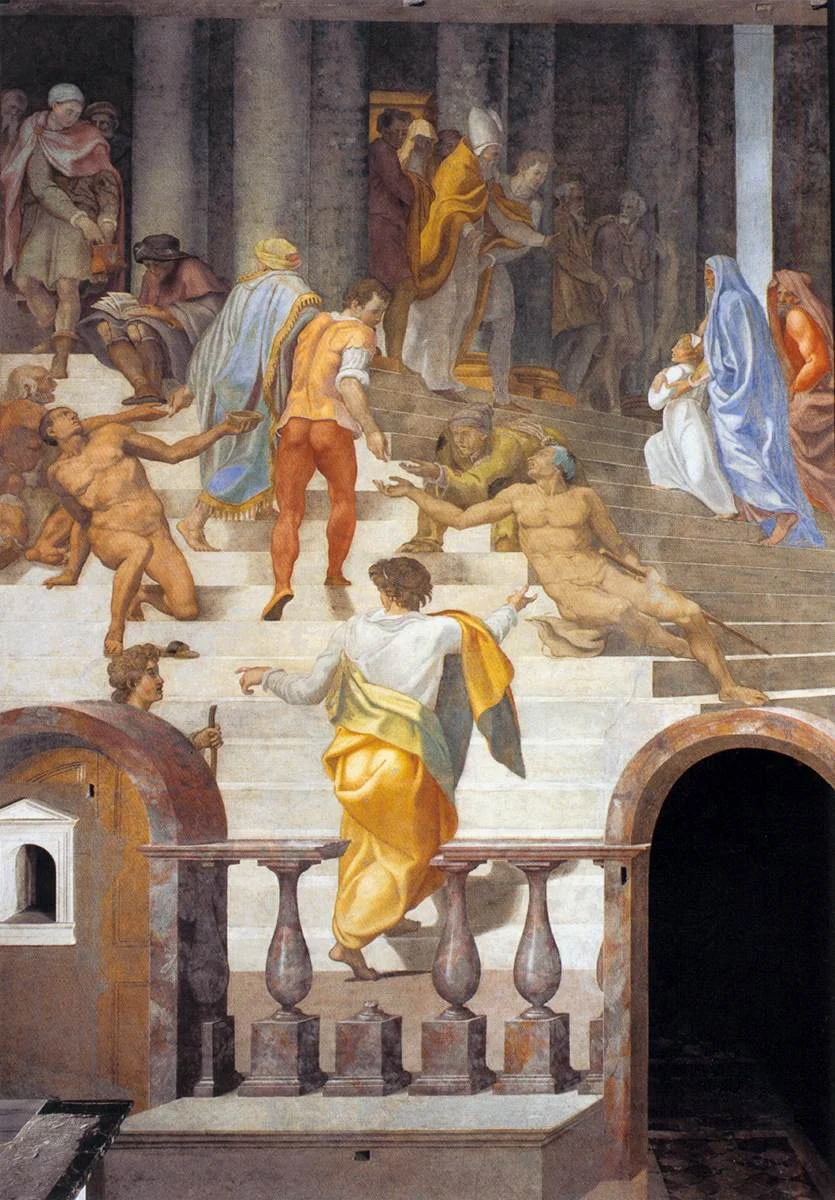The Cellini Salt Cellar (in Vienna called the Saliera, Italian for salt cellar) is a part-enamelled gold table sculpture by Benvenuto Cellini. It was completed in 1543 for Francis I of France, from models that had been prepared many years earlier for Cardinal Ippolito d'Este. The Cellini Salt Cellar depicts a male figure representing the sea and a female figure that represents the earth. A small vessel meant to hold salt is placed next to the male figure. A temple-shaped box for pepper is placed next to the female figure.
Home » Tutti i post

Benvenuto Cellini | Saliera or Salt Cellar, 1540-1543

Francesco Primaticcio | Ulysses and Penelope, 1563
Francesco Primaticcio, also called Bologna, Le Primatice, or Primadizzi (born April 30, 1504, Bologna, Emilia [Italy]-died 1570, Paris, France), Italian Mannerist painter, architect, sculptor and leader of the first school of Fontainebleau.
Primaticcio was first trained as an artist in Bologna, under Innocenzo da Imola and later Bagnacavallo.
He also studied with Giulio Romano and assisted him in his work on the decorations of the Palazzo del Te in Mantua.

Daniele da Volterra | Unfinished portrait of Michelangelo, 1544
Artist: Daniele da Volterra (Daniele Ricciarelli🎨) (Italian painter🎨, Volterra 1509–1566 Rome)
Date: probably ca. 1544
Medium: Oil on wood
Dimensions: 34 3/4 x 25 1/4 in. (88.3 x 64.1 cm)
Classification: Paintings
Credit Line: Gift of Clarence Dillon, 1977
Accession Number: 1977.384.1

Daniele da Volterra | Mannerist style painter / sculptor
Daniele da Volterra - Presentation of the Virgin
Daniele Ricciarelli da Volterra (1509-1566) was born in Volterra, a town in Tuscany, the painter and sculpture became known as Daniele da Volterra. He was a mannerist artist best remembered for his work in connection to Michelangelo (1475-1564).
Before befriending Michelangelo, Volterra studied in Siena with Giovanna Antonio Bazzi, called Il Sodoma (1477-1549) and Baldassare Peruzzi (1481-1537), and then with Piero Buonaccorsi, called Perin del Vaga (1501-1547). During this time he helped to complete works in the Palazzo Massimo alle Colonne in Rome, as well as in the Trinitá dei Monti and the San Marcello al Corso.
Volterra’s commission for the Orsini Chapel in the Trinitá dei Monti, were frescos he did based on drawings by Michelangelo.

Pierre-Gérard Langlois | Abstract painter
Born in 1940 and died young, at fifty four years, in 1994, Pierre-Gérard Langlois was an French painter and lithographer. He signed some of his work the pseudonym G. Duroc.
He graduated from the Modern Arts School of Paris, then he attended the Academy of Beaux-Arts at Rouen and followed courses at the Ecole du Louvre. He had his first personal exhibition in 1965, in Paris at the Champs Elysées Théatre.

Rembrandt | Musical Company, 1626
The subject of this painting is a mystery: is it an exhortation to praise God through singing and string music, or a scene of seduction with the old woman as a procuress?
In any case, in this early work Rembrandt used elements from his own surroundings: his mother modelled for the old woman, and Rembrandt’s own features can be recognized in the young man. | Rijksmuseum, Amsterdam
Rembrandt | Musical Company, 1626 | Rijksmuseum, Amsterdam
On the face of it, the theme of Music Allegory is straightforward enough: a music party in an interior, a common subject in Dutch art, though one to which Rembrandt himself would never return.
Three figures - a seated young woman singing, a man playing a bass gamba and a standing youth playing the harp - make music while an older woman listens on.

Rubens and Brueghel | The Five Senses Allegory | Art workshops
The "Five Senses" is a set of Allegorical paintings created at Antwerp in 1617-1618 by two Flemish masters Jan Brueghel the Elder (Dutch painter, 1568-1625) and Peter Paul Rubens (Dutch painter 1577-1640), with Brueghel being responsible for the settings and Rubens for the figures.
They are now in the Prado Museum in Madrid.
They are all painted in oils on wood panel, approximately 65 by 110 centimetres (2 ft 2 in × 3 ft 7 in) in dimensions.
Peter Paul Rubens and Jan Bruegel the Elder | Allegory of Sight, 1617 | Museo del Prado

Thomas Sully | Portrait painter
Thomas Sully (1783-1872) was born in 1783 in Horncastle, Lincolnshire, England, the youngest son of nine children born to the actors Matthew and Sarah Chester Sully. At the suggestion of his father's brother-in-law, a theater manager in Virginia and South Carolina, the Sullys emigrated to the United States in 1792. Sully attended school in New York until his mother's death in 1794, when he returned to live with his family in Richmond. From there they moved to Charleston, South Carolina, where the future artist performed on the stage with his parents and siblings.
Iscriviti a:
Commenti (Atom)











